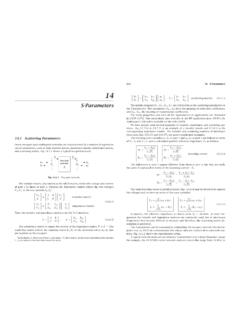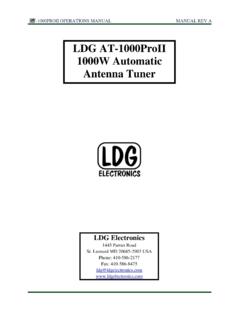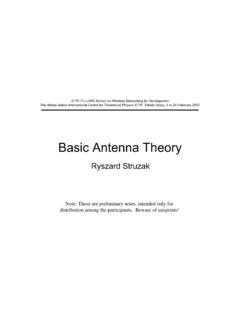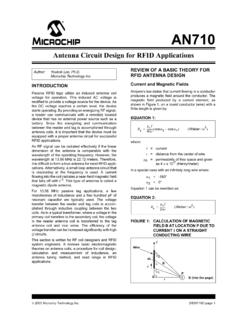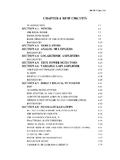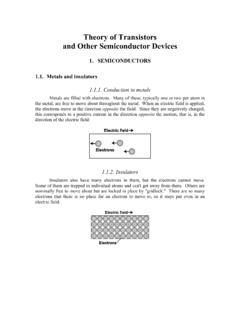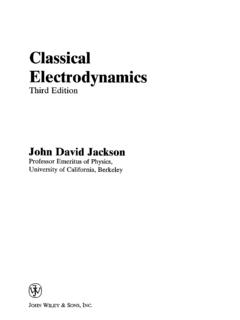Transcription of 22.1 Antenna Arrays
1 Lens Antennas1087where the left-hand side represents the optical pathFPAB. Geometrically, we haveRcos +d=FandF=R0+h0. EliminatingdandR0, we find the lens profile:R=F 1 1n 1 1ncos ( )which is recognized to be the equation for an ellipse with eccentricity and focal lengthe=1/nandF1= the above discussion, we considered only the refracted rays through the dielectricand ignored the reflected waves. These can be minimized by appropriate Antenna ArraysArrays of antennas are used to direct radiated power towards a desired angular number, geometrical arrangement, and relative amplitudes and phases of the arrayelements depend on the angular pattern that must be an array has been designed to focus towards a particular direction, it becomesa simple matter tosteerit towards some other direction by changing the relative phasesof the array elements a process shows some examples of one- and two-dimensional Arrays consistingof identical linear antennas.
2 A linear Antenna element, say along thez-direction, hasan omnidirectional pattern with respect to the azimuthal angle . By replicating theantenna element along thex-ory-directions, the azimuthal symmetry is broken. Byproper choice of the array feed coefficientsan, any desired gain patterng( )can the Antenna element is replicated along thez-direction, then the omnidirectionalitywith respect to is maintained. With enough array elements, any prescribed polar anglepatterng( )can be this section we discuss array design methods and consider various design issues,such as the tradeoff between beamwidth and sidelobe uniformly-spaced Arrays , the design methods are identical to the methods fordesigning FIR digital filters in DSP, such as window-based and frequency-sampling de-signs. In fact, historically, these methods were first developed in Antenna theory andonly later were adopted and further developed in Translational Phase ShiftThe most basic property of an array is that the relative displacements of the Antenna ele-ments with respect to each other introduce relativephase shiftsin the radiation vectors,which can then add constructively in some directions or destructively in others.
3 This isa direct consequence of the translational phase-shift property of Fourier transforms: atranslation in space or time becomes a phase shift in the Fourier Translational Phase Shift1089 Fig. array shows on the left an Antenna translated by the vectord, and on theright, several antennas translated to different locations and fed with different current density of the translated Antenna will beJd(r)=J(r d). By definition,the radiation vector is the three-dimensional Fourier transform of the current density,as in Eq. ( ). Thus, the radiation vector of the translated current will be:Fd= ejk rJd(r)d3r= ejk rJ(r d)d3r= ejk (r +d)J(r )d3r =ejk d ejk r J(r )d3r =ejk dF109022. Antenna Arrayswhere we changed variables tor =r d. Thus,Fd(k)=ejk dF(k)(translational phase shift)( ) array Pattern MultiplicationMore generally, we consider a three-dimensional array of several identical antennas lo-cated at positionsd0,d1,d2.
4 With relative feed coefficientsa0,a1,a2,.., as shownin Fig. (Without loss of generality, we may setd0=0 anda0=1.)The current density of thenth Antenna will beJn(r)=anJ(r dn)and the corre-sponding radiation vector:Fn(k)=anejk dnF(k)The total current density of the array will be:Jtot(r)=a0J(r d0)+a1J(r d1)+a2J(r d2)+ and the total radiation vector:Ftot(k)=F0+F1+F2+ =a0ejk d0F(k)+a1ejk d1F(k)+a2ejk d2F(k)+ The factorF(k)due to a single Antenna element at the origin is common to all , we obtain thearray pattern multiplicationproperty:Ftot(k)=A(k)F(k)( array pattern multiplication)( )whereA(k)is thearray factor:A(k)=a0ejk d0+a1ejk d1+a2ejk d2+ ( array factor)( )Sincek=k r, we may also denote the array factor asA( r)orA( , ). To summarize,the net effect of an array of identical antennas is to modify the single- Antenna radiationvector by the array factor, which incorporates all the translational phase shifts andrelative weighting coefficients of the array may think of Eq.
5 ( ) as the input/output equation of a linear system withA(k)as thetransfer function. We note that the corresponding radiation intensities andpower gains will also be related in a similar fashion:Utot( , )=|A( , )|2U( , )Gtot( , )=|A( , )|2G( , )( )whereU( , )andG( , )are the radiation intensity and power gain of a single el-ement. The array factor can dramatically alter the directivity properties of the single- Antenna element. The power gain|A( , )|2of an array can be computed with the helpof the MATLAB functiongain1dof Appendix L with typical array Pattern Multiplication1091[g, phi] = gain1d(d, a, Nph);% compute normalized gain of an arrayExample :Consider an array of two isotropic antennas at positionsd0=0 andd1= xd(alternatively, atd0= (d/2) xandd1=(d/2) x), as shown below:The displacement phase factors are:ejk d0=1,ejk d1=ejkxd=ejkdsin cos or, in the symmetric case:ejk d0=e jkxd/2=e jk(d/2)sin cos ,ejk d1=ejkxd/2=ejk(d/2)sin cos Leta=[a0,a1]be the array coefficients.
6 The array factor is:A( , )=a0+a1ejkdsin cos A( , )=a0e jk(d/2)sin cos +a1ejk(d/2)sin cos ,(symmetric case)The two expressions differ by a phase factor, which does not affect the power pattern. Atpolar angle =90o, that is, on thexy-plane, the array factor will be:A( )=a0+a1ejkdcos and the azimuthal power pattern:g( )=|A( )|2= a0+a1ejkdcos 2 Note thatkd=2 d/ . Figure showsg( )for the array spacingsd= ,d= ,d= ,orkd= /2, ,2 , and the following array weights:a=[a0,a1]=[1,1]a=[a0,a1]=[1, 1]a=[a0,a1]=[1, j]( )The first of these graphs was generated by the MATLAB code:d = ; a = [1,1];%dis in units of [g, phi] = gain1d(d, a, 400);% 400 phi s in[0, ]dbz(phi, g, 30, 20);%30ogrid, 20-dB scale109222. Antenna Arrays 90o 90o 0o180o 60o 60o30o 30o120o 120o150o 150o 5 10 15dBd = , a = [1, 1] 90o 90o 0o180o 60o 60o30o 30o120o 120o150o 150o 5 10 15dBd = , a = [1, 1] 90o 90o 0o180o 60o 60o30o 30o120o 120o150o 150o 5 10 15dBd = , a = [1, j] 90o 90o 0o180o 60o 60o30o 30o120o 120o150o 150o 5 10 15dBd = , a = [1, 1] 90o 90o 0o180o 60o 60o30o 30o120o 120o150o 150o 5 10 15dBd = , a = [1, 1] 90o 90o 0o180o 60o 60o30o 30o120o 120o150o 150o 5 10 15dBd = , a = [1, j] 90o 90o 0o180o 60o 60o30o 30o120o 120o150o 150o 5 10 15dBd = , a = [1, 1] 90o 90o 0o180o 60o 60o30o 30o120o 120o150o 150o 5 10 15dBd = , a = [1, 1] 90o 90o 0o180o 60o 60o30o 30o120o 120o150o 150o 5 10 15dBd = , a = [1, j]Fig.
7 Gain patterns of two-element isotropic the relative phase ofa0anda1changes, the pattern rotates so that its main lobe is ina different direction. When the coefficients are in phase, the pattern is broadside to thearray, that is, towards =90o. When they are in anti-phase, the pattern is end-fire, thatis, towards =0oand = technique of rotating or steering the pattern towards some other direction by intro-ducing relative phases among the elements is further discussed in Sec. There, wewill be able to predict the steering angles of this example from the relative phases of observation from these graphs is that as the array pattern is steered from broad-side to endfire, the widths of the main lobes become larger. We will discuss this effect inSects. and array Pattern Multiplication1093 Whend , more than one main lobes appear in the pattern. Such main lobes are calledgrating lobes or fringes and are further discussed in Sec.
8 Fig. shows someadditional examples of grating lobes for spacingsd=2 ,4 , and 8 . 90o 90o 0o180o 60o 60o30o 30o120o 120o150o 150o 5 10 15dBd = 2 , a = [1, 1] 90o 90o 0o180o 60o 60o30o 30o120o 120o150o 150o 5 10 15dBd = 4 , a = [1, 1] 90o 90o 0o180o 60o 60o30o 30o120o 120o150o 150o 5 10 15dBd = 8 , a = [1, 1]Fig. lobes of two-element isotropic :Consider a three-element array of isotropic antennas at locationsd0=0,d1=d x, andd2=2d x, or, placed symmetrically atd0= d x,d1=0, andd2=d x,asshown below:The displacement phase factors evaluated at =90oare:ejk d0=1,ejk d1=ejkxd=ejkdcos ejk d2=ej2kxd=ej2kdcos Leta=[a0,a1,a2]be the array weights. The array factor is:A( )=a0+a1ejkdcos +a2e2jkdcos Figure showsg( )=|A( )|2for the array spacingsd= ,d= ,d= ,orkd= /2, ,2 , and the following choices for the weights:a=[a0,a1,a2]=[1,1,1]a=[a0,a1,a2] =[1,( 1),( 1)2]=[1, 1,1]a=[a0,a1,a2]=[1,( j),( j)2]=[1, j, 1]( )where in the last two cases, progressive phase factors of 180oand 90ohave been introducedbetween the array MATLAB code for generating the last graph was:109422.
9 Antenna Arrays 90o 90o 0o180o 60o 60o30o 30o120o 120o150o 150o 5 10 15dBd = , a = [1, 1, 1] 90o 90o 0o180o 60o 60o30o 30o120o 120o150o 150o 5 10 15dBd = , a = [1, 1, 1] 90o 90o 0o180o 60o 60o30o 30o120o 120o150o 150o 5 10 15dBd = , a = [1, j, 1] 90o 90o 0o180o 60o 60o30o 30o120o 120o150o 150o 5 10 15dBd = , a = [1, 1, 1] 90o 90o 0o180o 60o 60o30o 30o120o 120o150o 150o 5 10 15dBd = , a = [1, 1, 1] 90o 90o 0o180o 60o 60o30o 30o120o 120o150o 150o 5 10 15dBd = , a = [1, j, 1] 90o 90o 0o180o 60o 60o30o 30o120o 120o150o 150o 5 10 15dBd = , a = [1, 1, 1] 90o 90o 0o180o 60o 60o30o 30o120o 120o150o 150o 5 10 15dBd = , a = [1, 1, 1] 90o 90o 0o180o 60o 60o30o 30o120o 120o150o 150o 5 10 15dBd = , a = [1, j, 1]Fig. gains of three-element isotropic = 1; a = [1,-j,-1];[g, phi] = gain1d(d, a, 400);dbz(phi, g, 30, 20);The patterns are similarly rotated as in the previous example.
10 The main lobes are narrower,but we note the appearance of sidelobes at the level of 10 dB. We will see later that asthe number of array elements increases, the sidelobes reach a constant level of about 13dB for an array with uniform sidelobes can be reduced further if we use appropriate non-uniform weights, but atthe expense of increasing the beamwidth of the main lobes. array Pattern Multiplication1095 Example :As an example of a two-dimensional array , consider threez-directed half-wave dipoles: one at the origin, one on thex-axis, and one on they-axis, both at a distanced= /2, as shown relative weights area0,a1,a2. The displacement vectors ared1= xdandd2= Eq. ( ), we find the translational phase-shift factors:ejk d1=ejkxd=ejkdsin cos ,ejk d2=ejkyd=ejkdsin sin and the array factor:A( , )=a0+a1ejkdsin cos +a2ejkdsin sin Thus, the array s total normalized gain will be up to an overall constant:gtot( , )=|A( , )|2g( , )=|A( , )|2 cos( cos )sin 2 The gain pattern on thexy-plane ( =90o) becomes:gtot( )= a0+a1ejkdcos +a2ejkdsin 2 Note that becaused= /2, we havekd=.
